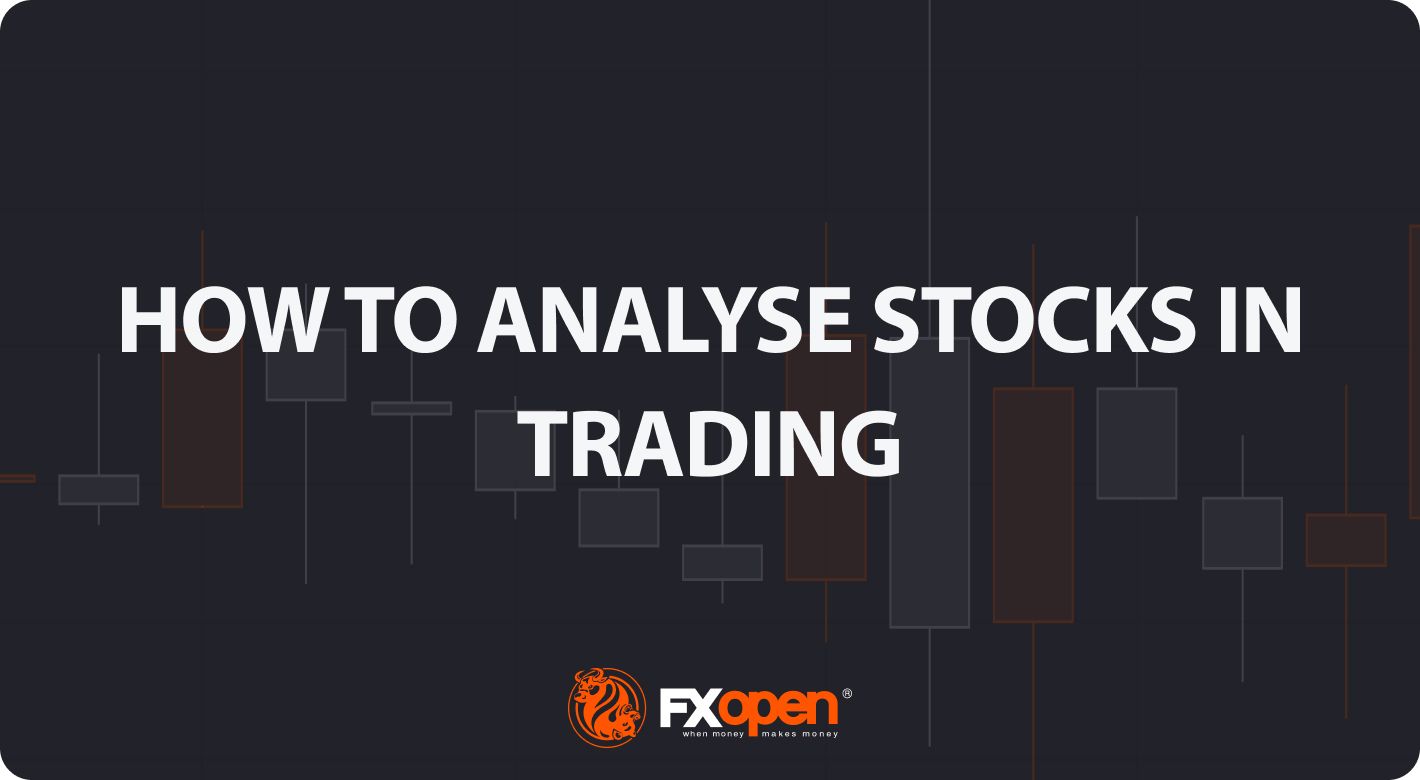FXOpen

Stock analysis is a fundamental skill. It goes beyond numbers and charts and involves dissecting a company's finances, scrutinising market dynamics, and predicting future trends. As an aspiring trader, knowing how to analyse stocks is essential to making informed decisions. It can be a complex process, but anyone can master this skill. Follow along as we explore the key factors to consider when analysing stocks.
Fundamental Analysis
Fundamental analysis is a method that scrutinises a company's finance system. It's all about examining factors like the company's financial reports, assets, management, and target market. By doing this, traders can figure out the actual value of a stock, helping them make informed trading decisions based on the company's true value.
Company Overview
As a case study, Microsoft is a giant that produces software like Bing (a search engine), cloud solutions, and Windows (a computer operating system).
As of September 2023, Microsoft's market cap is $2.355 trillion, and it is the second most valuable company in the world. This basic information about the company is helpful to traders because it gives them an idea of the stock's price direction.
Stock Financial Analysis
Reviewing financial statements is one of the stock analysis methods:
1. Income Statement
An income statement, also known as a profit and loss statement (P&L), is a financial report that summarises a company's revenues, expenses, and profits or losses over a specific period, usually a quarter or a year.
2.Balance Sheet
The balance sheet gives traders insight into a company's financial health within a defined timeframe. It is used by investors, creditors, and management to assess a company's financial stability, solvency, and overall financial health.
3.Cash Flow Statement
The cash flow statement tracks the cash flow in and out of a company over a specific period, providing insights into how cash is generated from operating, investing, and financing activities that a company deploys in specific market situations.
Ratios and Metrics for Stock Trading Analysis
Many financial ratios and metrics can be used to assess a company's financial performance, but some of the most common and important ones are:
1. Price-to-Earnings (P/E) Ratio:
The P/E ratio measures the market value of a company's stock relative to its Earnings per Share (EPS). It assesses a company's stock relative value in the stock market.
2. Price-to-Sales (P/S) Ratio:
The Price-to-Sales (P/S) ratio is used to assess the valuation of a company's stock in relation to its revenue or sales. It can help investors and analysts gauge how the market values a company's stock relative to its top-line revenue.
3. Price-to-Book (P/B) Ratio:
The price-to-book ratio evaluates the price of a company's stock with a book value share. The book value per share represents the value of the company's assets minus its liabilities, divided by the number of outstanding shares.
4. Dividend Yield:
The dividend yield can provide insight into a company's dividend policy and ability to generate consistent profits. A company with a high dividend yield may appeal to traders looking for long-term investments.
5. Earnings Per Share (EPS):
Earnings Per Share represents the portion of a company's profit (earnings) allocated to each outstanding share of its common stock. It is a fundamental indicator used to assess a company's profitability on a per-share basis.
Industry and Market Analysis
Among the various types of stock analysis, understanding the industry and market conditions is crucial for achieving long-term success. Here are some points important for industry and market analysis:
1. Market Trends
Market trends help traders to assess the overall direction of the market. By analysing trends such as consumer preferences, buying patterns, and economic factors, traders can anticipate changes in demand, identify growth opportunities, and develop trading strategies.
2. Competitive Position
A company's competitive position, often referred to as its competitive advantage or market position, describes its relative standing and strength within its industry or market.
3. Regulatory Factors
Regulatory factors refer to the rules, laws, and regulations set by government bodies and authorities that affect businesses and industries.
Management and Leadership
Evaluating a company's management team is essential in stock trading analysis because it helps assess its ability to make decisions that drive company performance and navigate market challenges.
1. Leadership Quality
Competent and experienced executives are likely to make strategic decisions that drive the company's growth and profitability. Stock traders often look for companies with strong leadership teams.
2. Corporate Governance
Strong corporate governance practices can protect the rights and interests of shareholders, ensuring that executives act in the company's and its investors' best interests. Traders often favour companies with robust governance practices as they are less likely to face governance-related issues that impact stock performance.
Technical Analysis
Technical analysis examines historical price charts and patterns to predict future price movements. This is a list of some of the best stock analysis tools and indicators for analysing price trends. You can use FXOpen’s free TickTrader platform to practise them.
Price Charts
Standard price charts that are useful for stock trading analysis include:
1. Line Chart: The line chart is the simplest and most basic chart form. It plots the closing prices of a stock over a specified period.
2. Bar Chart: The bar chart provides more information than the line chart. It displays a stock's open, high, low, and closing prices for each time period.
3. Candlestick Chart: Similar to the bar chart, the candlestick chart represents the open, high, low, and closing prices, but candlesticks include a wide body that makes it easier to identify patterns and read trends.
Technical Indicators
Common technical indicators useful for stock trading analysis include:
1. Moving Averages calculate the average price over a specified period.
2. The Relative Strength Index (RSI) measures the speed and change of price movements, indicating overbought or oversold conditions.
3. Moving Average Convergence Divergence (MACD) identifies potential trend reversals and price momentum.
4. Bollinger Bands determine price volatility.
5. The Stochastic Oscillator indicates potential trend reversals and overbought/oversold conditions.
Chart Patterns
Common chart patterns for stock trading analysis include:
1. Head and Shoulders/Inverse Head and Shoulders are a sign of a potential trend reversal.
2. The Double Top/Double Bottom indicates a potential reversal in the trend.
3. Bullish/Bearish Engulfing Patterns indicate when the market may change its direction.
Sentiment Analysis
Market sentiment is one of the types of analysis in the stock market. It plays a crucial role in stock analysis as it reflects traders' overall attitude and perception towards a particular stock or the overall market.
News and Events
News, events, and earnings reports impact stock prices by influencing trader confidence and sentiment. Positive news or reports often lead to increased demand and higher stock prices, while negative news can result in lower stock prices.
Social Media and Forums
Positive or negative sentiments expressed by influential individuals or many users on social media and online forums can impact trader perceptions and ultimately influence stock prices.
Conclusion
Trends and market conditions can shift rapidly, and new information can emerge unexpectedly. Therefore, it’s vital to monitor trades continuously. By constant monitoring, traders can assess whether the original investment thesis still holds, evaluate risk-reward dynamics, and make informed decisions about potential adjustments. If you are ready to start analysing stock markets, you can open an FXOpen account and get access to hundreds of markets.
This article represents the opinion of the Companies operating under the FXOpen brand only. It is not to be construed as an offer, solicitation, or recommendation with respect to products and services provided by the Companies operating under the FXOpen brand, nor is it to be considered financial advice.
Stay ahead of the market!
Subscribe now to our mailing list and receive the latest market news and insights delivered directly to your inbox.








